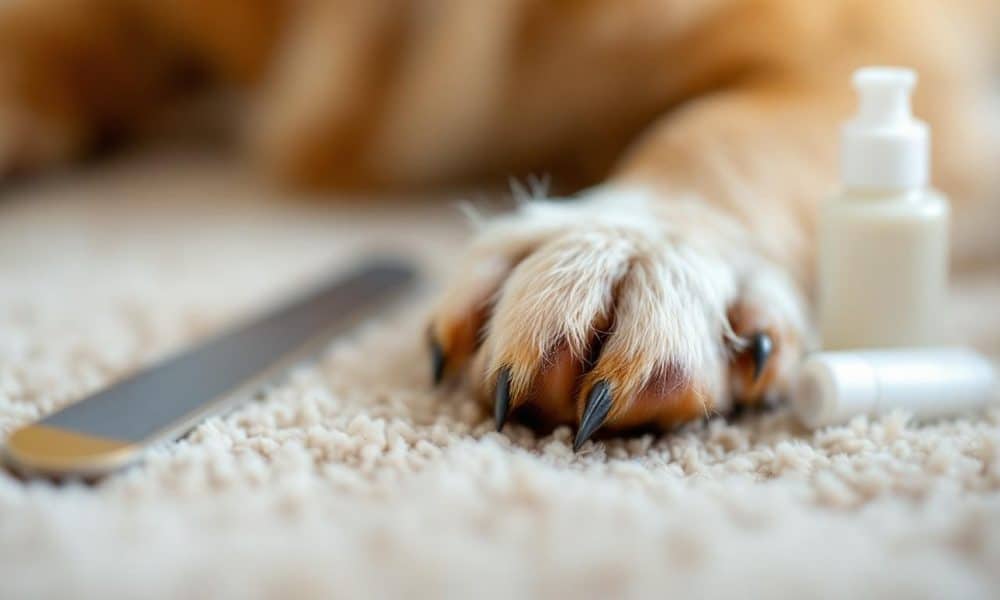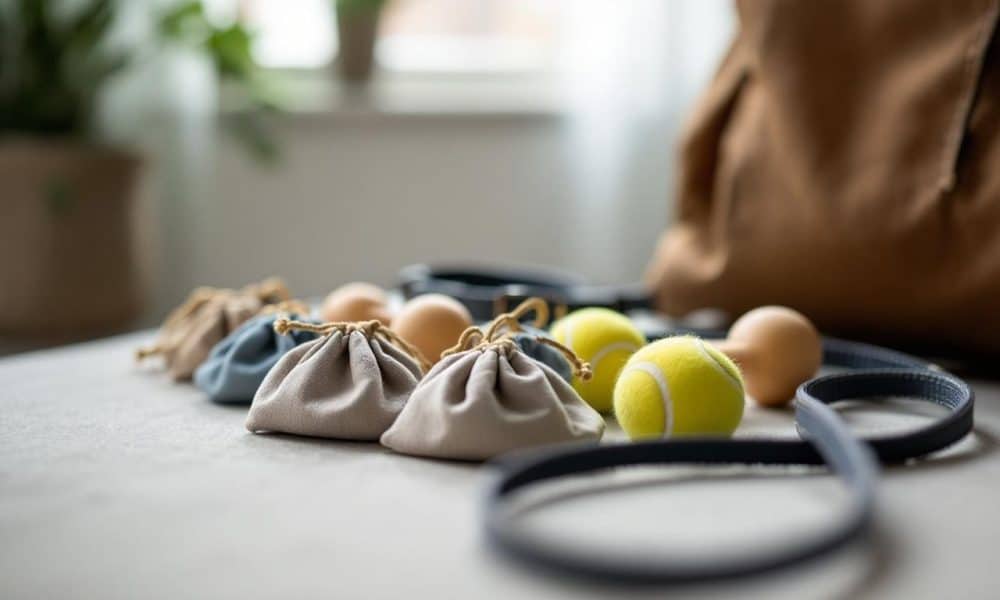
“This post contains affiliate links, and I will be compensated if you make a purchase after clicking on my links.”
Professional grooming costs can reach $100 per session, but safety scissors dog grooming at home offers a budget-friendly alternative. Many pet owners feel intimidated by the prospect of trimming their dog’s fur themselves.
We at DogingtonPost believe that with the right tools and techniques, you can safely groom your dog at home. The key lies in using proper safety scissors and following proven methods that protect both you and your pet.
Which Safety Scissors Do You Actually Need
Blunt-Tip Scissors Protect Sensitive Areas
Blunt-tip scissors represent the gold standard for trimming sensitive areas around your dog’s eyes, ears, and nose. These scissors feature rounded ends that prevent accidental punctures, which makes them indispensable for facial grooming. The American Pet Products Association provides leading research on pet industry statistics, yet most pet owners use regular household scissors that pose significant injury risks. Professional groomers consistently choose 4-6 inch blunt-tip scissors for precision work, as longer blades reduce control in tight spaces.
Curved Scissors Shape Your Dog’s Natural Lines
Curved scissors excel at creating smooth, rounded cuts that follow your dog’s body contours. These specialized tools work best for trimming around paws, shaping leg hair, and creating natural-looking curves on the chest and hindquarters. Professional-grade curved scissors with 6-inch blades provide optimal control for most breeds under 50 pounds.
The curve direction matters significantly – right-handed groomers should choose right-curved scissors, while left-handed users need left-curved options for proper cutting angles.
Thinning Shears Prevent Harsh Lines
Thinning shears have teeth on both edges and are the best choice for bulk thinning dogs coats and removing hair close to the skin. These scissors remove approximately 40% of hair with each cut, which makes them perfect for reducing bulk in thick coats and softening harsh scissor lines. Quality thinning shears cost $50-80 but last years with proper maintenance (when you clean and oil them regularly). Use them sparingly on double-coated breeds like Golden Retrievers, as over-thinning can damage the undercoat’s insulating properties. Sharp thinning shears prevent hair pulling, which causes discomfort and makes dogs resist future grooming sessions.
Once you select the right scissors for your dog’s specific needs, the next step involves preparing your pet for a stress-free grooming experience.
How Do You Set Up Your Dog for Safe Grooming
Create a Stable Work Surface With Proper Lighting
Set up your station on a sturdy table with a non-slip mat to prevent your dog from sliding during the session. Professional groomers use tables 30-36 inches high to reduce back strain and maintain better control over the scissors. Position your workspace near a window or use bright LED lighting with at least 1,000 lumens to see hair growth patterns clearly.
The Journal of Veterinary Behavior research shows that dogs experience 40% less stress when you groom them in familiar environments rather than new locations. Keep treats within arm’s reach and place scissors in a shallow container to prevent accidental drops that could startle your pet.

Apply Gentle Control Methods That Work
Hold your dog’s paw firmly but gently with your non-dominant hand while you trim, never grip tightly around the neck or muzzle. For anxious dogs, wrap them loosely in a towel with only the area you plan to trim exposed – this technique reduces movement as a less restrictive alternative to full-body restraint by providing control of the head.
Start sessions when your dog is naturally tired (such as after a walk or play session). Dogs under 25 pounds can be held securely on your lap for facial trimming, while larger breeds should remain standing on the surface.
Complete Pre-Trimming Preparation Steps
Always brush your dog thoroughly before you pick up scissors, as matted hair can pull painfully and cause sudden movements that lead to cuts. Check for skin irritations, cuts, or unusual lumps during this inspection – note any abnormalities and avoid them during trimming.
This preparation phase sets the foundation for the actual scissor techniques that will transform your dog’s appearance safely and effectively.
How Do You Execute Each Cut Safely
Master the Eye Area With Micro-Movements
Hold blunt-tip scissors parallel to your dog’s face, never point them directly at the eyes. Cut only 2-3 hairs at a time with tiny snips rather than long cuts – this prevents accidental overcutting that creates uneven patches around the sensitive eye area. Professional groomers at the National Dog Groomers Association recommend the scissor-over-comb technique for dogs with thick facial hair: hold a fine-tooth comb flat against the skin and trim only the hair that extends beyond the comb’s teeth.
This method maintains consistent length while it protects the skin underneath. Position your dog’s head at eye level to avoid awkward angles that reduce precision. Dogs with protruding eyes like Pugs need extra caution – work in 30-second intervals with treats between cuts to prevent head shaking that could cause injury.

Execute Paw Trimming With Strategic Positioning
Lift each paw and spread the toes gently to expose the hair that grows between pads – this overgrown hair traps dirt and moisture that leads to bacterial infections. Cut this interdigital hair flush with the pad surface with straight scissors angled away from the skin. The hair around nail beds requires curved scissors to follow the natural toe shape without harsh straight lines.
Pododermatitis is inflammation of the paw skin, including interdigital spaces, footpads, nail folds, and nails, which makes this trimming step essential for health rather than just appearance. Trim the hair on top of each paw to match the surrounding leg length, work against the grain for cleaner cuts. Hold the scissors at a 45-degree angle when you shape leg hair to create natural tapers that blend seamlessly with the body coat. Inspect your dog’s paws for existing cuts or cracks before you begin trimming.
Shape Body Hair With Proper Angles
Position curved scissors to follow your dog’s natural body contours when you trim chest and leg areas. Cut with the hair growth direction on the body, but cut against the grain on legs to achieve better definition. Professional groomers use the “point cutting” technique – they hold scissors at a 45-degree angle to the hair shaft rather than cutting straight across (this creates softer, more natural-looking edges).
Work in small sections no larger than 2 inches at a time to maintain control and consistency. Check your progress frequently by stepping back to view the overall shape – uneven areas become obvious from a distance but remain hidden during close-up work.
Final Thoughts
Safety scissors dog grooming becomes second nature with consistent practice and proper technique. Always sanitize your scissors after each session and store them in protective cases to maintain their sharpness. Sharp tools reduce the risk of hair pulling and skin irritation that makes dogs resist future sessions.
Professional groomers handle complex cuts, severely matted coats, or aggressive dogs that pose safety risks. Seek expert help when your dog shows signs of extreme stress (such as excessive panting or attempts to bite during sessions). Breeds with specific coat requirements like Poodles or Cocker Spaniels benefit from professional shaping every 6-8 weeks.
Start with short 10-minute sessions and gradually increase duration as your dog becomes comfortable with the process. Most pet owners achieve competent trimming skills within 4-6 sessions when they follow proper techniques consistently. The Dogington Post provides comprehensive resources for responsible dog ownership, including expert advice and product reviews.







